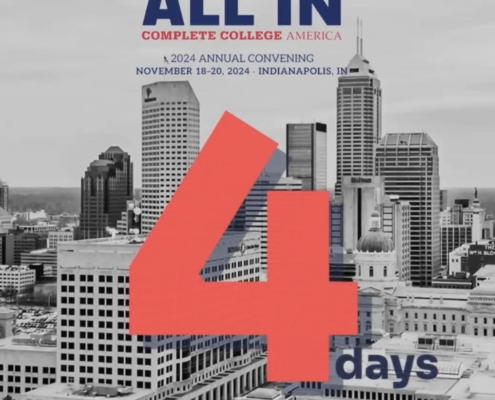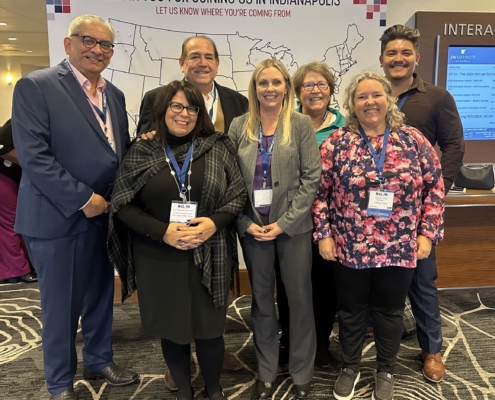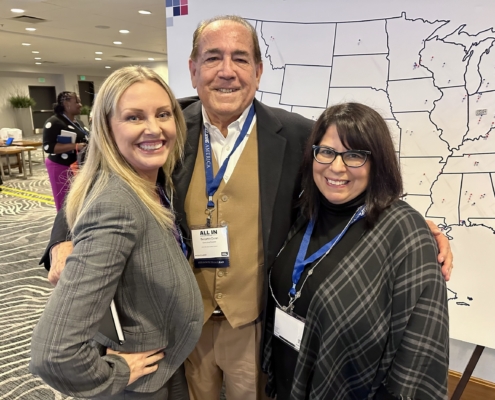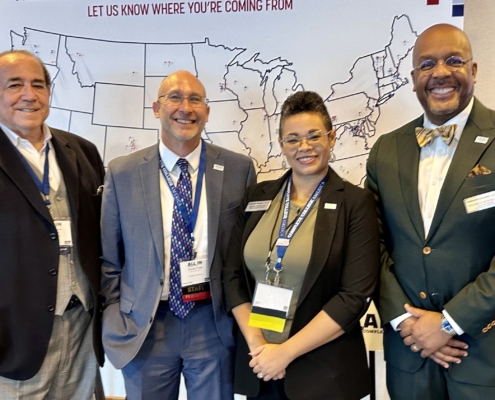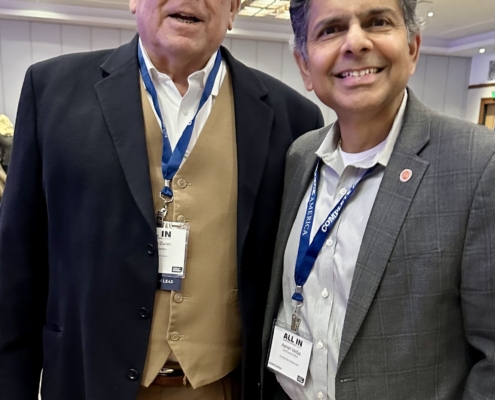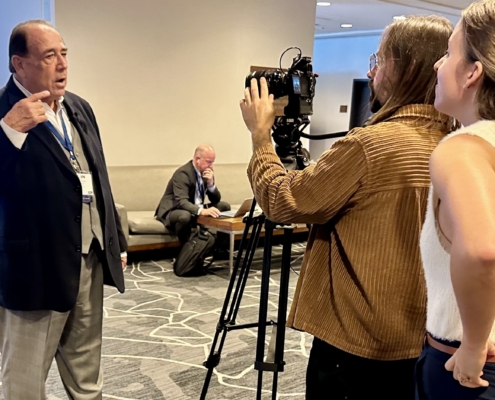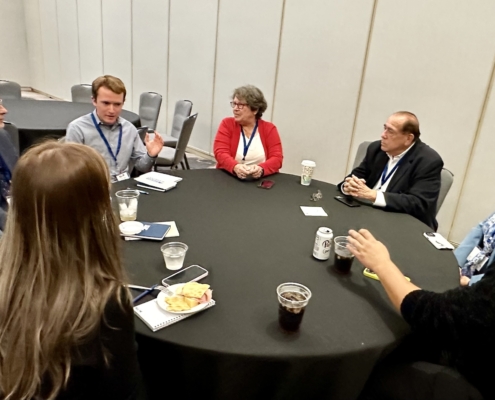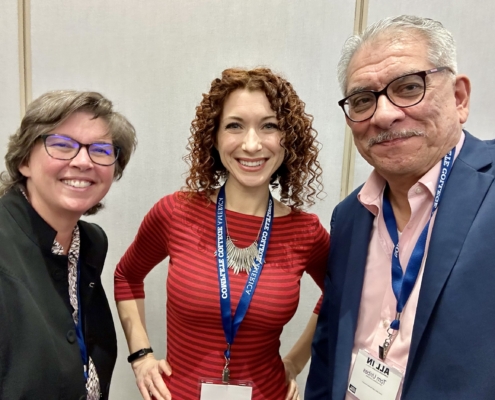‘What the CV-HEC is Happening’ Blog: CCA keynote Dr. Jamie Merisotis (Lumina Foundation)
With the advent of a new year, and many new developments across the nation and worldwide, we kick off our first Central Valley Higher Education Consortium newsletter of the year with a special guest edition of our blog featuring a reprint of the speech delivered by Jamie Merisotis, president of the Lumina Foundation, at the Complete College America (CCA) Conference in Indianapolis, Indiana last November: “Progress in a Time of Disruption: the Urgency of Reimagining Higher Ed.” CVHEC sent a delegation to the three-day conference Nov. 18-20 which drew 800 participants from throughout the country who heard Dr. Merisotis issue both an alarm that higher education is at a crossroads and a call to positive action through system changes in higher ed. An internationally recognized leader in higher education, human work, philanthropy, and public policy, Dr. Merisotis has been Lumina Foundation’s president and CEO since 2008. He is a national media commentator and contributor and is currently a regular Forbes contributor. Previously, Dr. Merisotis was president of the nonpartisan, D.C.-based Institute for Higher Education Policy, which he co-founded. He was also the executive director of a bipartisan national commission, appointed by the president and congressional leaders, to study college affordability. A distinguished graduate and trustee emeritus of Bates College, he has been awarded honorary degrees from colleges and universities worldwide. Dr. Merisotis is the author of America Needs Talent, named a Booklist Top 10 Business book of 2016, and Human Work in the Age of Smart Machines, an Amazon bestseller released in 2020.
Progress in a Time of Disruption:
The Urgency of Reimagining Higher Ed
Remarks by Dr. Jamie Merisotis, president/CEO, Lumina Foundation, at the Complete College America Convening
Tuesday, November 19, 2024 in Indianapolis, Indiana. He was introduced by Dr. Yolanda Watson Spiva, CCA president.
I’m delighted to be with so many close partners and friends in state leadership roles. I’m especially pleased to be part of this convening, because the missions of Complete College America and Lumina have so much in common. We both work to advance ideas and policies to enable more Americans to get the higher education that’s critical to our country’s future. We both see the urgency of reimagining higher ed to meet the needs of today’s students and today’s society. And we both put special focus on reaching those who have too often been left out.
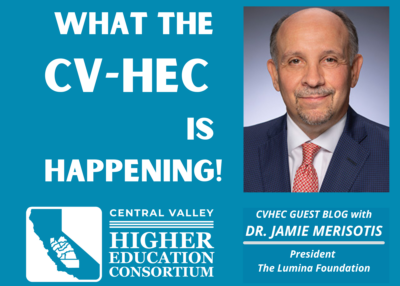 I’m proud of the work that CCA and Lumina have done together in many different ways. For example, we’ve been working to build a network for Black community colleges where leaders can come together to identify strategies and policies that will enable institutions to better serve adults of color. Lumina and CCA have both long pointed out and worked to remedy the systemic inequities, inefficiencies, and unfairness in higher education.
I’m proud of the work that CCA and Lumina have done together in many different ways. For example, we’ve been working to build a network for Black community colleges where leaders can come together to identify strategies and policies that will enable institutions to better serve adults of color. Lumina and CCA have both long pointed out and worked to remedy the systemic inequities, inefficiencies, and unfairness in higher education.
More broadly, CCA’s influence has been pivotal to the significant gains we’ve tried to catalyze in our work at Lumina when it comes to higher education attainment. Those gains, and the enormous benefits derived from millions more people attaining postsecondary credentials, are among the least well-understood stories of broad social progress that this nation has achieved in the last decade.
We need to keep this progress going, because we’re clearly living in a time of ongoing disruption. We haven’t fully escaped the impacts of COVID on higher ed and the country at large. Artificial intelligence is advancing with great speed and uncertainty. The devastation of climate change — on both property and lives — is no longer hypothetical and off in some distant future. It is here today and growing in frequency and severity. The widening war in the Middle East has led to a surge of campus protests as explosive as any since the 1960s.
And of course, sitting here in November of 2024, the presidential election signals a major change of direction for the country and for higher education.
It is early yet, but we all know that President-elect Trump’s pronouncements on higher education, and his prior record from 2017-2020, point toward a challenging time ahead for higher education.
From the efforts to obliterate DEI and target undocumented students, to efforts to undo the student debt relief advanced by the Biden administration, to rhetoric about eliminating the US Department of Education and dismantling the accreditation system, there is no shortage of things that will challenge, frustrate, and possibly realign the fundamental relationship of higher education institutions to the federal government.
Much has been written about the intense polarization in our country, including a supposedly inexorable divide in views of higher education among red and blue states. But if I can take liberties with Mark Twain, our own work shows that some of those reports have been greatly exaggerated. For example, Texas, led by Republicans, and Illinois, led by Democrats, are both reevaluating and increasing funding for higher ed. Texas recently redesigned how it funds community colleges, while Illinois is taking on how it funds universities.
Both states agree that more equitable distribution of taxpayer dollars across higher education is vital and that more resources are needed to help students earn credentials valued in the workplace. And the 21st century industries that all states are pursuing – things like renewable energy, AI, chip-making, advanced manufacturing, and biologics – all require the kinds of skills, creativity and problem-solving abilities that come from higher education.
So I think everyone in this room will acknowledge that this is a pivotal moment for American higher ed. My point simply is that this polarization is not a new challenge, but a more extreme one.
Now I know you share my frustration that, at a time when higher education has never been more important for our citizens or our country, we’re facing stiff headwinds everywhere we look. And while there was a welcome uptick in enrollment last year, we’ve struggled again this year. This reflects a longer-term trend, one where the total number of undergraduates is more than a million fewer than in 2018, and two million fewer since 2012.
So we must be clear-eyed about our current challenges.
Not only have we seen a long-term enrollment decline, but the fact that there are fewer Americans under 18 makes this trend difficult to reverse. Throw in a robust job market, and the fact that fewer than two-thirds of high school graduates are going on to college — a percentage well down from a decade ago — and the headwinds become a hurricane.
But the biggest concern is that for the first time in American history, many are questioning whether higher education is still worth it.
According to a Gallup poll, confidence in higher education is at an all-time low, with only 36% of Americans saying they have “a great deal” or “quite a lot” of confidence in higher education. This is a 20-point drop from eight years ago.
Higher education is at a crossroads. It can push back on the critiques that have led to this declining confidence. That certainly makes sense in a number of ways, since many of the criticisms of higher education ARE distortions. They are often caricatures of the unique world of elite, highly selective institutions, where relatively few students attend college. Those distortions leave little room for understanding what really happens on most college campuses.
But higher education also has an opportunity, which is to use this moment of extreme stress to pursue genuine, urgently-needed systemic change. Bluntly stated, this means calling BS on the outrageous distortions about higher education while also pursuing urgently-needed changes. These things are both possible, and not in contradiction. Let me explain what I mean.
Let’s start first with the facts about why higher education has been and remains a fundamental building block of American greatness.
For individuals, the data are clear that a bachelor’s degree is still the surest route to the middle class. A study from Georgetown University’s Center on Education and the Workforce found a lifetime gain of $1.2 million for those with bachelor’s degrees.
Of course, the benefits of going to college go beyond making more money. Many studies say that today’s workers will typically have 10 or more jobs over their lifetimes, and we know that college embeds habits — such as discipline, curiosity, and critical thinking — that give one a leg up on learning new things. This is true for people who earn any postsecondary credential – bachelor’s degrees, associate degrees, certificates, and other credentials.
The data are also clear that people without education past high school not only earn less than those with some higher education — they also struggle more.
They’re more prone to depression, they need more government assistance, they pay less taxes, they divorce more frequently, they vote and volunteer less often, they even live shorter lives. The latest research by Anne Case and Angus Deaton — the Princeton economists who coined the term “deaths of despair” — reveals that the gap in life expectancy between Americans with college degrees and those without has surged to 8½ years.
We also can’t overlook the tremendous societal and national value of higher ed.
In a recent op-ed in our local Indianapolis newspaper, Ball State University Economist Michael Hicks points out that the combination of business incentives and cuts to funding of higher education has left Indiana’s economy weaker vis-à-vis other states. He concludes this way:
“To put it as plainly as possible: Educational attainment alone is now a more powerful predictor of a region’s economic success than everything else combined.”
Let me share one more argument I’ve been making in gatherings like this.
The economy’s shift from high-paying manufacturing jobs to technology-mediated office work requiring college education has made life more challenging, broadening the popular appeal of authoritarianism. It’s a global phenomenon, and even here in the United States we’re seeing the growing appeal of strict obedience to authority at the expense of personal freedom.
We know the solution: Studies going back decades have shown that higher levels of education make it less likely people will turn away from democracy. Data from surveys that track authoritarian leanings show that higher levels of education reduce such beliefs and values. The election results are in line with these findings: College-educated people were far more likely to reject the rhetoric that praises dictators and disdains democracy.
Higher ed promotes independent thought and curiosity. It exposes people to other cultures and ideas. It can equip people to handle complexity, differences, and rapid societal changes. A better-educated population, then, is not only essential to individual prosperity — what we have long called the “good jobs and good life” dividends of education — but also shared prosperity, the strongest bulwark against growing threats to our democratic way of life.
So, we can all agree that, when it comes to value, of course higher ed is worth it. That’s been the case throughout our country’s history, and the evidence is overwhelming that it’s still the case.
But that doesn’t mean that the system as it’s been for the past century or more is sufficient going forward. High costs have put too many schools out of reach for many Americans. The system is inflexible and hard to understand. College schedules often don’t work for today’s students — more of whom are older, working, many with families of their own. And students are often unsure if their coursework will prepare them for today’s jobs.
Higher ed must be responsive to what society needs, and those needs have evolved in light of global, technological, economic and social changes.
The good news is that many states get it and are adapting. Data show that price increases are easing — sometimes dramatically — and states are expanding scholarships and need-based aid.
More states are encouraging schools to look at options like three-year degrees rather than the traditional four-year model. They’re looking at non-degree credentials and offering more flexible scheduling to meet the needs of today’s learners. More states are creating real financial incentives for schools to partner with businesses to ensure they’re teaching in-demand skills, and are using internships, apprenticeships, stackable credentials and other programs to give their students entrée into good jobs.
I mentioned the Texas funding increases, which are in a bill known as HB 8. The legislation focuses on awarding “credentials of value” — defined as degrees, certificates, or credentials that offer, in the words of the bill, “purpose in the economy, value in the labor market, and opportunities for good jobs and meaningful careers.”
Lumina, CCA, and many other organizations also are putting renewed emphasis on tying degrees and credentials to return on investment, good jobs, more opportunities for further education, and other measures of value.
Let me also single out two areas that remain at the heart of our mission.
First is the importance of continuing to bring an equity lens to this work despite the current backlash against DEI and other such efforts. Again, speaking candidly, we should not leave it to others to define what equity is.
There has been a long-standing and widely understood agreement about what equity is about. It’s about ensuring that everyone has access to resources and opportunities to succeed, including—and in particular—those who have been historically disadvantaged or underrepresented. It acknowledges that people come from different places and have different needs. Equity in education is important because it’s aimed at ensuring that the outcomes of learning cannot be predicted based on one’s race, ethnicity, income, or geographic location. That enduring definition is in the best interests of everyone, and that’s what we need to make clear.
We know that, for all the efforts going back decades, gaps in educational attainment have long existed due to historical, social, systemic, and structural factors that continue to persist. Our collective futures depend on bringing off the sidelines the people who too often have been left out.
A recent report from Georgetown’s Center on Education and the Workforce provides powerful evidence of why this matters. It notes that the proportion of people with degrees increased 6.7 percentage points from 2010 to 2020, and as a result, US workers will earn more than $14 trillion more over their lifetimes.
Of course, it’s not just the college graduates who benefit. When people earn more, they spend more — not only on cars, homes, and groceries but on their own communities through civic involvement and charitable giving.
The Georgetown center’s analysis also found that if all racial and ethnic groups reached the same educational levels as white Americans, those groups would see an additional $11 trillion in net lifetime earnings, on top of the $14 trillion all graduates will gain.
What this means is that we’ve got to do a better job of designing policies and programs to meet the needs of today’s students, especially regarding affordability and academic quality. Programs from the humanities to sciences and specialized technical programs must be made more affordable and built to support students who are more likely to work while in school, provide care for family members, and experience economic insecurity. Programs should be completed in reasonable time frames, offer scheduling flexibility, and lead to family-sustaining livelihoods.
Second, I want to underscore the importance of developing not just productive individuals but informed, engaged citizens.
I mentioned earlier how even the US is not immune from the appeal of authoritarianism — which is on the rise around the world and is arguably reflected in the recent US election results.
Research has shown that education plays a key role in protecting democracy, but that role has often been understated, undervalued, and underinvested. Our task now is to highlight more clearly the continuing economic and social benefits of higher ed while also making the case that it’s one of our best bets to help protect democracy. Increasing college attainment alone will not solve all our nation’s challenges with cohesion and democratic vitality, but the sector can do more to play a positive role.
There’s an opportunity now to build bridges — despite the many signs of increased polarization. Among the reform efforts needed in higher education, we must reimagine higher ed’s role in preparing people for active, informed citizenship.
It’s not just about voting—as important as that is. Active citizenship requires us to be truly engaged in our communities and society. And to support that effort, educators must connect learning with the persistent issues that confront individuals and their communities.
That means answering tough questions, including:
What do people actually need to learn and experience to prepare them to be better equipped for the human work of today and tomorrow while also serving as engaged and active citizens?
How do we respond to the torrents of misinformation in ways that allow us to work across our differences?
How can we reckon with America’s troubled past and present, particularly as it relates to race, ethnicity, income, and geography, while also working toward a brighter future?
And, how can we show young Americans that education can equip them to have a real impact on the problems they see around them?
At the end of the day, we need to make clear what higher education is FOR, not just what it is against. Thinking about why higher ed is so valuable — and what it is truly for — points us in the right direction. It can lead us to the most productive responses, at a time when such responses are desperately needed.
Advancing American talent through a robust system of higher education is the best pathway to individual and shared economic prosperity. Graduates equipped with 21st century skills and immersive experiences in problem-solving, communication, digital literacy, critical thinking, teamwork, and other foundational skills have higher wages. They also are the best contributors to their communities and are the best defenders of freedom and democracy.
Even more than in past gatherings, this is our leadership moment, a time for creativity, for new approaches, a time when we need to think of strategy — not in terms of either-or, but both-and.
So this meeting could not be more timely, and I’m very much looking forward to our panel and to hearing what’s on your minds.
ABOUT LUMINA
Lumina Foundation is an independent, private foundation in Indianapolis committed to making opportunities for learning beyond high school available to all. We envision higher learning that is easy to navigate, delivers fair results, and meets the nation’s talent needs through a broad range of credentials. We work toward a system that prepares people for informed citizenship and success in a global economy.
See additional videos of CCA Conference.

